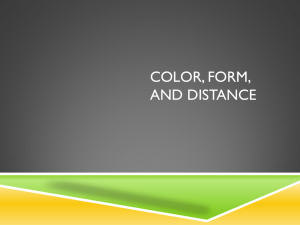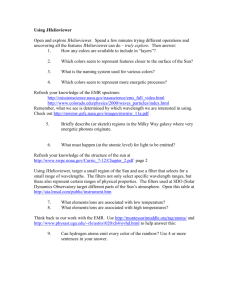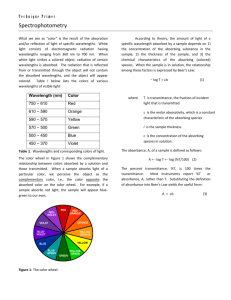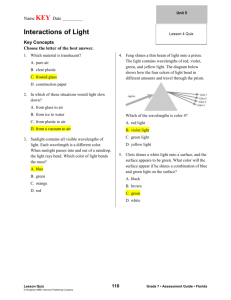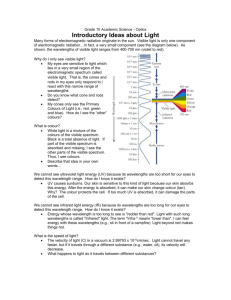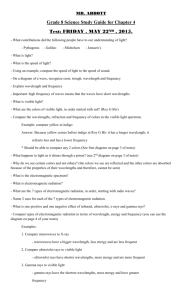Color Vision
advertisement
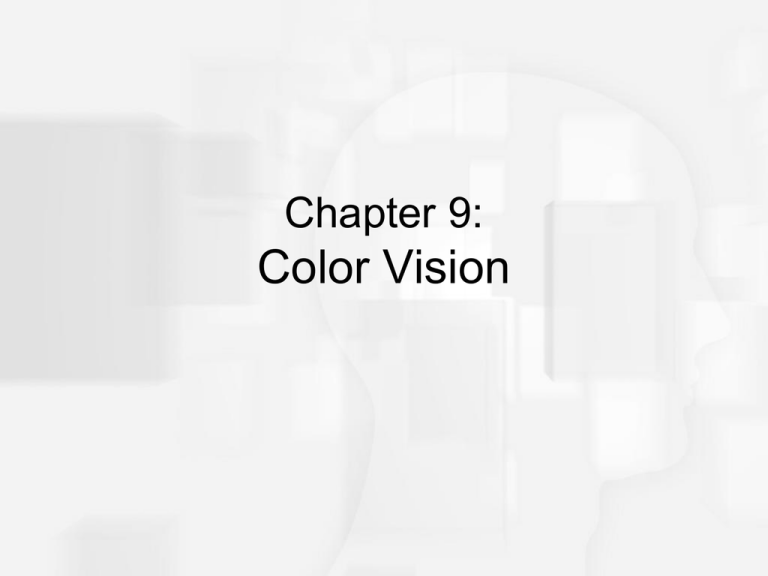
Chapter 9: Color Vision Overview of Questions • How do we perceive 200 different colors with only three cones? • What does someone who is “color-blind” see? • How does our memory of color affect our perception of color? Fruit of a different color just doesn’t look right. What Are Some Functions of Color Vision? • Color signals help us classify and identify objects. • Color facilitates perceptual organization of elements into objects. • Color vision may provide an evolutionary advantage in foraging for food. How Can We Describe Color Experience? • Colors can be changed by: – Intensity which changes perceived brightness – Saturation - adding white to a color results in less saturated color Chromatic Colors • Basic colors are red, yellow, green, and blue • Color circle shows perceptual relationship among colors • Chromatic colors or hues - objects that preferentially reflect some wavelengths Color wheel with exceptions • • • • • • • Some colors not in the color spectrum. White Gray Black Brow Achromatic colors – contain no hues What Is the Relationship Between Wavelength and Color Perception? • Color perception is related to the wavelength of light: 400 to 450nm appears violet 450 to 490nm appears blue 500 to 575nm appears green 575 to 590nm appears yellow 590 to 620nm appears orange 620 to 700nm appears red Figure 9.4 The visual spectrum. Table 9.1 Relationship between predominant wavelengths reflected and color perceived Colors of Objects • Colors of objects are determined by the wavelengths that are reflected • Reflectance curves - plots of percentage of light reflected for specific wavelengths – Called selective reflectance Figure 9.5 Reflectance curves for surfaces that appear white, gray, and black, and for blue, green and yellow pigments. Adapted from Clulow, F. W. (1972). Color: Its principles and their applications. New York: Morgan and Morgan. Selective transmission • Selective transmission: – Transparent objects, such as liquids, selectively allow wavelengths to pass through – Cranberry juice – Transmits long wavelengths – Looks red Additive: Mixing lights of different wavelengths All wavelengths are available for the observer to see Superimposing blue and yellow lights leads to white Color Mixing • Subtractive color mixture: – Mixing paints with different pigments – Additional pigments reflect fewer wavelengths – Mixing blue and yellow leads to green Figure 9.7 Color mixing with paint. Mixing blue paint and yellow paint creates a paint that appears green. This is subtractive color mixture. Trichromatic Theory of Color Vision • Proposed by Young and Helmholtz (1800s) – Three different receptor mechanisms are responsible for color vision. • Behavioral evidence: – Color-matching experiments • Observers adjusted amounts of three wavelengths in a comparison field to match a test field of one wavelength. Figure 9.8 In a color-matching experiment, the observer adjusts the amount of three wavelengths in one field (right) so it matches the color of the single wavelength in other field (left). Color Matching Experiments • Results showed that: – It is possible to perform the matching task – Observers with normal color vision need at least three wavelengths to make the matches. – Observers with color deficiencies can match colors by using only two wavelengths. Physiological Evidence for the Trichromatic Theory • Researchers measured absorption spectra of visual pigments in receptors (1960s). – They found pigments that responded maximally to: • Short wavelengths (419nm) • Medium wavelengths (551nm) • Long wavelengths (558nm) Figure 9.9 Absorption spectra of the three cone pigments. Figure 9.10 Patterns of firing of the three types of cones to different colors. The size of the cone symbolizes the size of the receptor’s response. Figure 9.14 (a) Ishihara plate for testing for color deficiency. A person with normal color vision sees a “74” when the plate is viewed under standardized illumination. (b) Ishihara plate as perceived by a person with a from of red-green color deficiency. Color Deficiency • Monochromat - person who needs only one wavelength to match any color • Dichromat - person who needs only two wavelengths to match any color • Anomalous trichromat - needs three wavelengths in different proportions than normal trichromat • Unilateral dichromat - trichromatic vision in one eye and dichromatic in other Color Experience for Monochromats • Monochromats have: – A very rare hereditary condition – Only rods and no functioning cones – Ability to perceive only in white, gray, and black tones – True color-blindness – Poor visual acuity – Very sensitive eyes to bright light Dichromacy • moderately severe color vision defect in which one of the three basic color mechanisms is absent or not functioning. It is hereditary and, in the case of Protanopia or Deuteranopia, sex-linked, affecting predominantly males. Dichromacy occurs when one of the cone pigments is missing and color is reduced to two dimensions. Protanopia (no red cone) • Protanopia is a severe type of color vision deficiency caused by the complete absence of red retinal photoreceptors. It is a form of dichromatism in which red appears dark. It is hereditary, sex-linked, and present in 1% of males and .02% of females Deuteranopia (no green cone) • a color vision deficiency in which the green retinal photoreceptors are absent, moderately affecting red–green hue discrimination. It is likewise hereditary and sex-linked. Deuteranopia affects 1% of males and .01% of females Dichromats Protanopia Deuteranopia Red-green deficiency Tritanopia (no blue cone) • Tritanopia is a very rare color vision disturbance in which there are only two cone pigments present and a total absence of blue retinal receptors. Not sex-linked. Tritanopia affects .002% of males and .001% of females Blue-yellow deficiency Scenes with color deficiency Afterimages Stare a box for 30 seconds a Opponent-Process Theory of Color Vision • Proposed by Hering (1800s) – Color vision is caused by opposing responses generated by blue and yellow, and by green and red. • Behavioral evidence: – Color afterimages and simultaneous color contrast show the opposing pairings – Types of color blindness are red/green and blue/yellow. Color matrix for afterimage and simultaneous contrast demonstrations. Results of afterimage and simultaneous contrast demonstration Three pairs of connections • Opponent-process mechanism – Three mechanisms - red/green, blue/yellow, and white/black – The pairs respond in an opposing fashion, such as positively to red and negatively to green – These responses were believed to be the result of chemical reactions in the retina. Figure 9.19 The three opponent mechanisms proposed by Hering. Physiology of Opponent-Process • Researchers performing single-cell recordings found opponent neurons (1950s) – Opponent neurons: • Are located in the retina and LGN • Respond in an excitatory manner to one end of the spectrum and an inhibitory manner to the other Trichromatic and Opponent-Process Theories Combined • Each theory describes physiological mechanisms in the visual system – Trichromatic theory explains the responses of the cones in the retina – Opponent-process theory explains neural response for cells connected to the cones further in the brain Figure 9.21 Our experience of color is shaped by physiological mechanisms, both in the receptors and in opponent neurons. Figure 9.9 Absorption spectra of the three cone pigments. Color Processing in the Cortex • There is no single module for color perception – Cortical cells in V1, V2, and V4 respond to some wavelengths or have opponent responses – These cells usually also respond to forms and orientations
